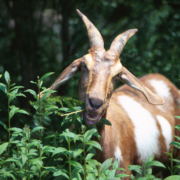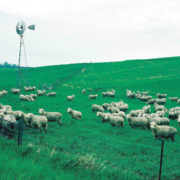All Chopped Up with Somewhere to Grow
 Print This Post
Print This Post
By Justin Duncan, NCAT Sustainable Agriculture Specialist
Recently we held a goat production class out in Luling, Texas, at the marvelous S3 Legacy Ranch. One question that came up was about feeding them. Goats are browsers—they’ll eat grass and weeds like cattle and sheep if they have to, but their preference is to eat brush. The problem we face is that we want to confine the goats, and in their confinement/boredom… they eat all the bushes and kill them. That’s a great trait for land-clearing. If you have an unkempt area on a farm, some highly predator- resistant fencing and a few goats will get it under control tout de suite! However, in long-term situations, it’s not so great for the animals, land, or, especially, the vegetation.
Since goats are browsers, we see that parasite loads increase in inverse proportion to vegetation height. The lower to the ground they feed, the more parasites they’ll have because the parasite’s life-cycle gets completed. We don’t want that. NO! We want high vegetation like brush, so the hatching intestinal nematodes die waiting on the ground while the goats are happily browsing well away from them. That’s the ideal but as we well know, that doesn’t always happen, and folks are going to raise their animals however they can. I am as guilty of that as anyone.
Rotation is a great way to break up the parasite cycle, too. There is much information about rotational grazing out there, so I won’t talk about it here. Instead, I’ll talk about some fun, labor-intensive stuff that will help you get your steps in for the day, will feed the goats, and is good for the soil.
Fast-growing leguminous trees such as Leucaena leucocephala or even Moringa oleifera can be grown near goat pens or even in the goat pens if allowed to size up before introducing the goats to the plants. Size up in this case means that the trees need to be tall enough to have the lower branches out of reach for a goat standing on its hind legs. These trees can be periodically cut and their leafy branches can be fed to the goats. Mulberry (Morus sp.) is also highly useful for this system of “cut and carry” but does not fix nitrogen like its leguminous counterparts. Mulberry, however, grows like a weed and is highly nutritious.
This concept can also be used to feed crops. Instead of throwing garden refuse away or composting it, one could instead chop it up and drop it as mulch back into the garden.
Both “cut and carry” and “chop and drop” allow for nutrient cycling, especially if the goat manure can be collected and used to fertilize the trees they are eating, closing that loop. Of course, additional nutrients must be added into the system to replace minerals lost through harvest/animal losses. These systems improve soil because they end up as mulch, one way or the other. And mulch covers the soil and protects it from degradation by the sun and allows for organic matter to build up.
Related ATTRA Resources:
Goats: Sustainable Production Overview
Sheep and Goats: Frequently Asked Questions
Tools for Managing Internal Parasites in Small Ruminants: Animal Selection
Tools for Managing Internal Parasites in Small Ruminants: Pasture Management
Ruminant Nutrition for Graziers
This blog is produced by the National Center for Appropriate Technology through the ATTRA Sustainable Agriculture program, under a cooperative agreement with USDA Rural Development. ATTRA.NCAT.ORG.








 NCAT
NCAT wikicommons Zeynel Cebeci
wikicommons Zeynel Cebeci
